A chronicle of the July Uprising
Md Shahnawaz Khan Chandan
On August 5, 2024 Bangladesh’s students and mass people achieved what some of the biggest political parties could not accomplish in the last 15 years—unseating an autocratic regime through a popular uprising.
When students’ demand for reforming the quota system in the government job sector was met with unprecedented violence, student leaders of different universities steered the movement in the ultimate direction of ousting Sheikh Hasina’s regime.
These students had to brave continuous threats from the police and intelligence agencies; they had to win vicious street battles with trigger happy law enforcement agencies and Awami League cadres when the protesters were only armed with sticks and pebbles; and they had to take an uncompromising stance defying all odds.
How it all began
When students took to the streets on July 1, 2024, demanding reforms of the quota system, they did not imagine that this movement was about to rewrite the history of Bangladesh.
Ganatantrik Chhatra Shakti (GCS), a students’ platform that came into being in 2023, started to organise peaceful demonstrations all over the country, protesting reinstatement of the quota system by the High Court on June 5.
Akram Hossain, a GCS leader and now a member of the Nagorik Committee, said, “Initially, we did not think that the protest for quota reform could turn into an anti-government movement. We did not have any intention to topple the government; we wanted to settle the issue peacefully by staging protests within university campuses.”
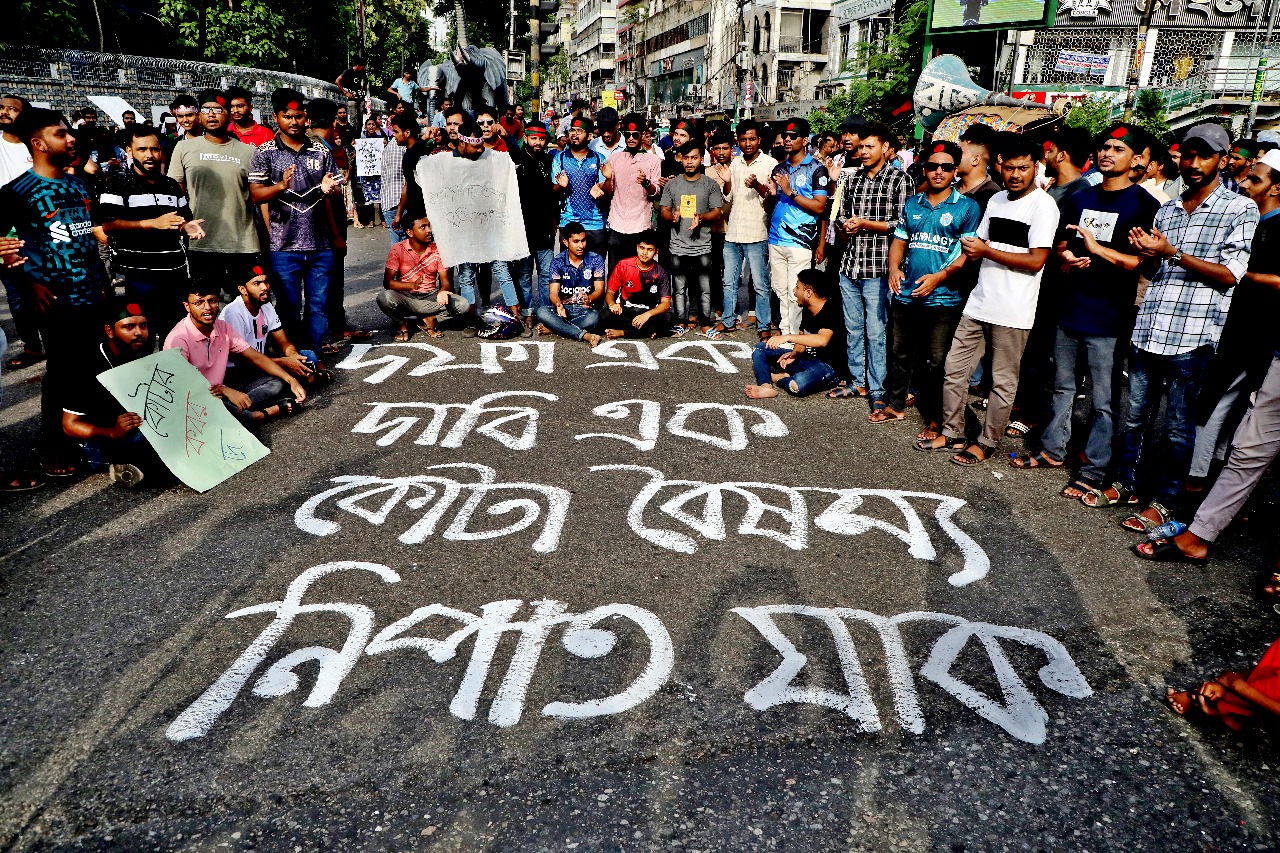
Ganatantrik Chhatra Shakti, a students’ platform that came into being in 2023, started to organise peaceful demonstrations all over the country, protesting reinstatement of the quota system by the High Court on June 5. Photo: Prabir Das
Then, on July 14, students at different dormitories of Dhaka University burst into anger when, at a press conference, the then prime minister Sheikh Hasina compared the student protesters to children and grandchildren of Razakars, a militia force manned by Bangalees who collaborated with the Pakistan army and fought against the freedom fighters during the Liberation War of 1971.
That night, agitated students took to the streets chanting the slogan “Who are you? Who am I? Razakar, Razakar.”
AB Zubair, a student leader of DU, who was one of the first persons to chant this slogan, said, “Through these slogans, we wanted to assert that we did not care about Hasina’s branding of anyone who did not submit to her command or who demanded justice in society as Razakar or anti-liberation force.” According to Zubair and several other leaders, the two lines, “Says who? Says who? The dictator, the dictator!”, were added later to the original slogan to avoid any misunderstanding.
Mito Akter, a student of DU’s Bangladesh-Kuwait Maitree Hall, recounted, “The press conference enraged me. As I was having dinner, I heard ‘Razakar, Razakar’ slogans from the massive processions going past my dormitory. I stopped eating and chanted the slogans from my balcony.”
“At first I was alone, but within minutes, hundreds of female students of my dormitory joined me. Many of us joined the procession too. I still feel goosebumps when I remember that night. I think that was the beginning of the end for Hasina,” added Mito.
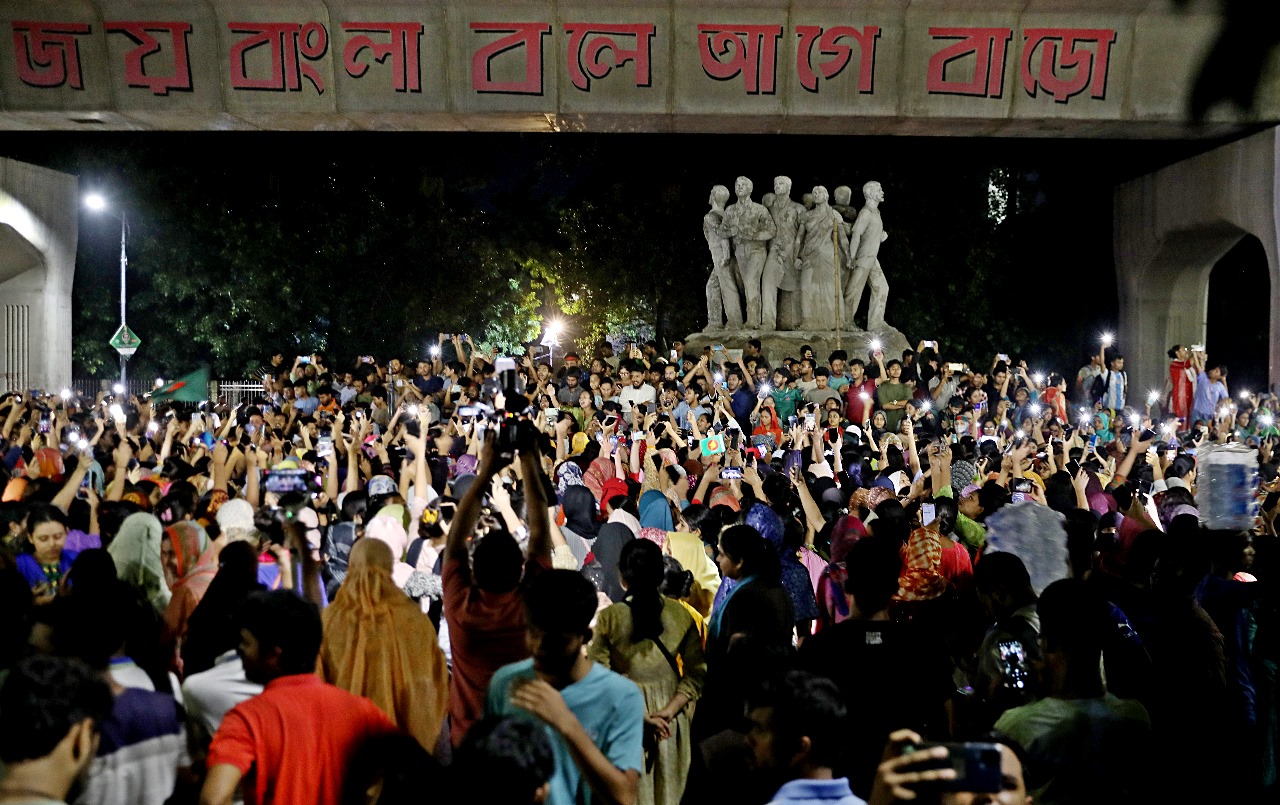
On July 14, students at different dormitories of Dhaka University burst into anger when, at a press conference, the then prime minister Sheikh Hasina compared the student protesters to children and grandchildren of Razakar. Photo: Star
The slogans and processions in defiance of Sheikh Hasina’s comment caused uproar among Bangladesh Chhatra League (BCL) leaders, who initially did not intervene with this year’s quota reform movement. They started to organise their activists against the protesting students, chanting slogans “Who are you? Who are you? Bangalee, Bangalee!” News broke out on social media that BCL activists had begun to confront and block students in the DU dorms from attending the larger processions.
Thanks to the circulating videos, students of Jahangirnagar University (JU) and Chittagong University (CU) also took to the streets.
Hasib Zaman, JU student and assistant general secretary of the JU chapter of Bangladesh Chhatra Union (BCU) said, “When we brought out processions protesting Sheikh Hasina’s remarks, we were soon confronted by BCL cadres. But they faced fierce resistance from the protesting students, and we can proudly say that JU was the first university to be declared free of BCL activists.”
According to him, the BCL activists launched violent attacks on the protesting students when they went to the vice chancellor’s bungalow to clarify their demands. In face of attacks, the protesters soon regrouped, resisted and finally evicted all the BCL cadres from the campus on July 15.
Students of CU also brought out massive processions. Mohammad Ali, a student leader of CU, said, “The slogan became massively popular among all students. Such a large number of students joined our procession that BCL activists did not dare resist us that night.”
Awami League versus the students
In response to students’ defiance, Obaidul Quader, the then general secretary of Awami League, commented at a party meeting that BCL is enough to subdue the unruly students.
On July 15, soon after Quader’s comment, BCL launched a vicious assault on female student protesters at DU. Beaten with rods, bamboo sticks and clubs, many were severely injured.
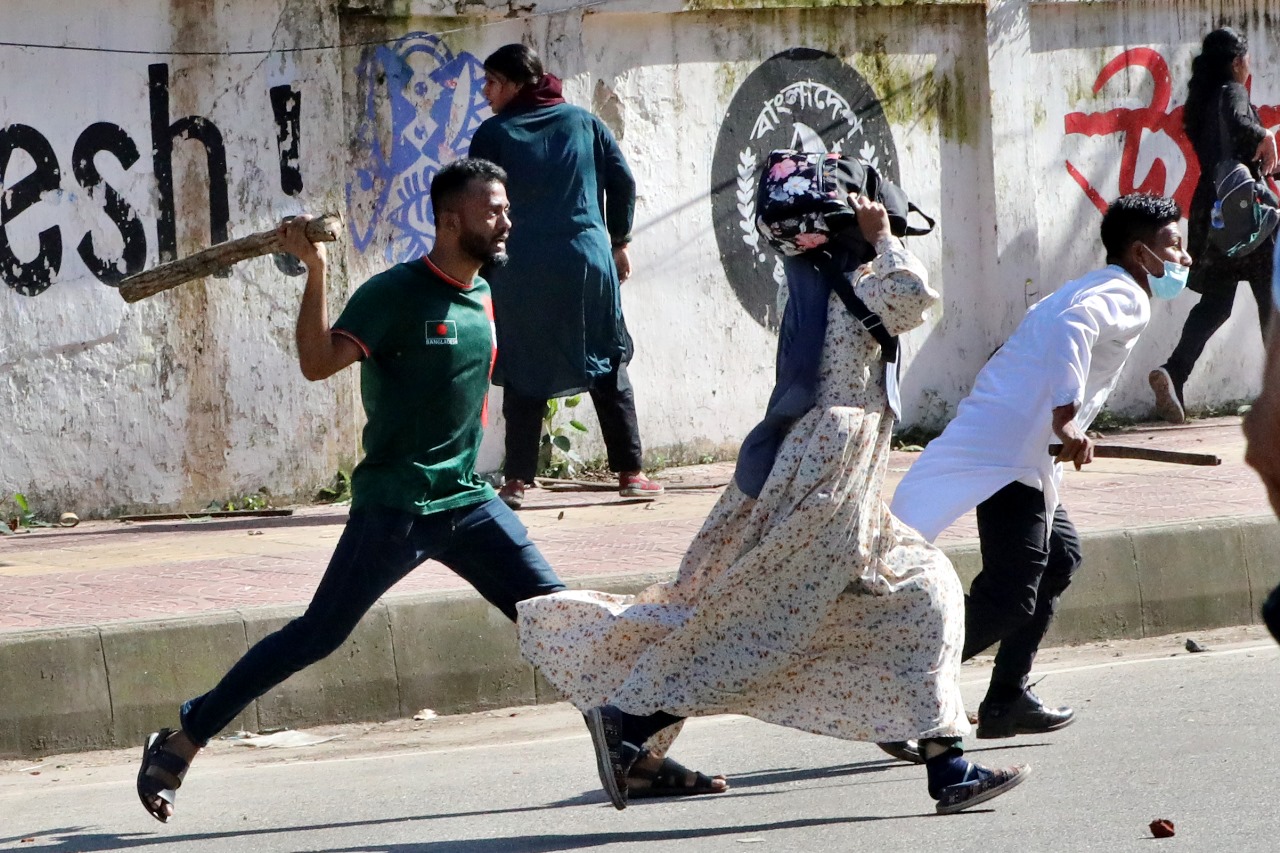
On July 15, BCL launched a vicious assault with rods, bamboo sticks and clubs on female student protesters at DU. Photo: Prabir Das
DU student Sanzida Afifa, one of the victims of that attack, recounted, “Around 500 armed BCL cadres rushed towards a peaceful protest organised by the female students of DU. They specifically targeted us and flogged us while shouting that we were Razakars and Pakistani agents.”
Mito Akter was also severely beaten. “I saw a sister faint but those thugs still beat her fallen body. I was also badly hurt, but somehow managed to limp to the Nilkhet Residential Area gate where some guards quickly took me inside. There I lost consciousness and after some primary treatment, I recovered.”
Students of all the public universities took to the streets again, protesting the vicious attack against the female students of DU.
Students of CU got involved in a violent clash with BCL activists when they staged a protest at Sholashohor Railway Station, which students use to reach the city from their university.
On July 16, the murder of Abu Sayed, a student of Begum Rokeya University, Rangpur, turned the tide of the movement.
Abdul Kader, a student leader of DU, recounted, “Videos showing how Abu Sayed was shot in cold blood sparked wildfire among student protesters. Abu Sayed’s courage against the armed police and his ultimate sacrifice inspired many people to join our movement who, perhaps, were never bothered about quota reform. He was the first martyr of the July uprising.”
On July 17, students of DU offered funeral prayers in absentia at Shaheed Minar and VC Chattar, which was attacked by police and BCL. Police threw numerous sound grenades at the students.
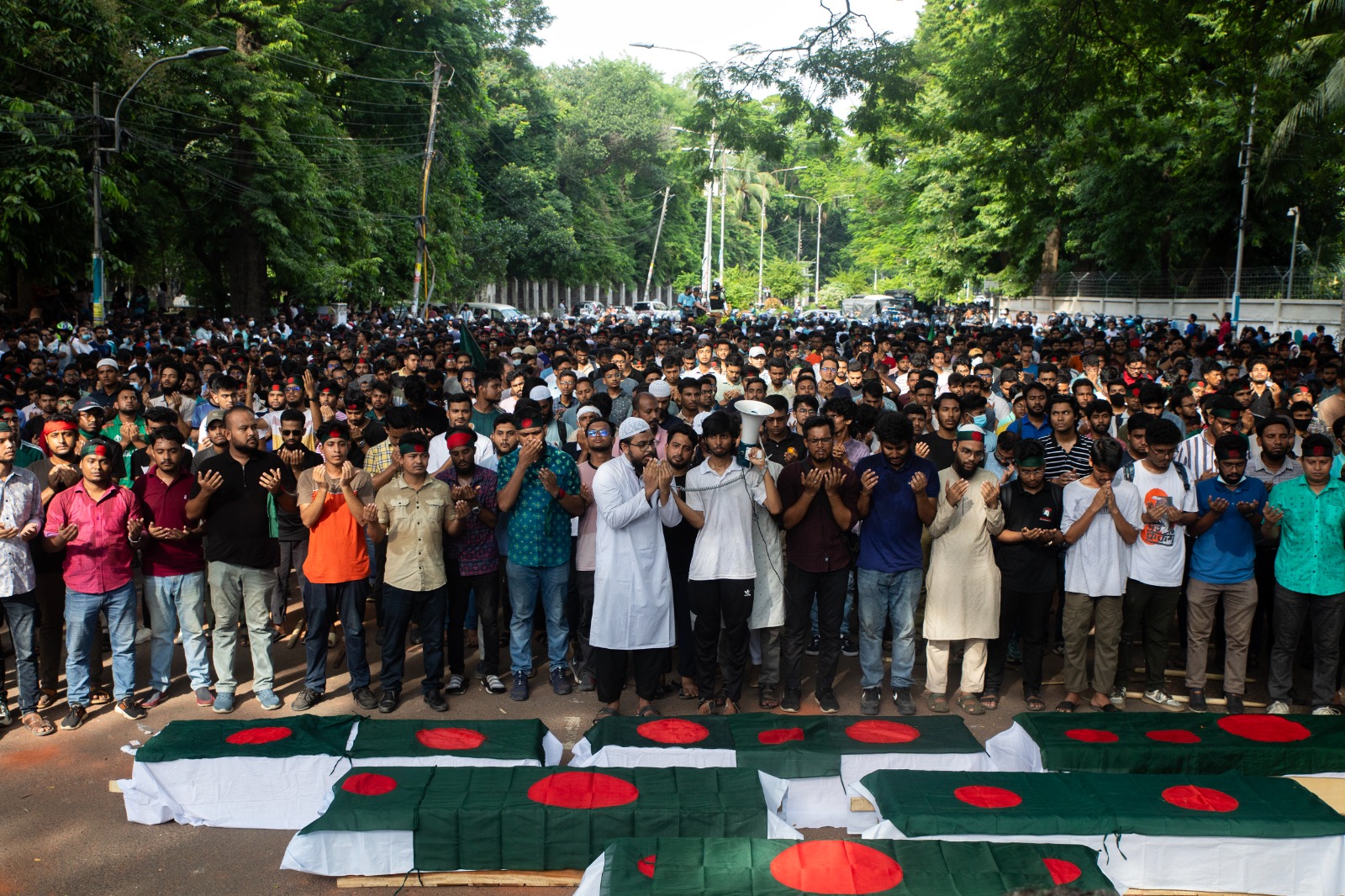
On July 17, students of DU offered funeral prayers in absentia at Shaheed Minar and VC Chattar, which was attacked by police and BCL. Police threw numerous sound grenades at the students. Photo: Orchid Chakma
Shadik Kayem, one of the student leaders of DU who later emerged as the president of DU chapter of Bangladesh Islami Chhatrashibir, said, “After vicious attacks on female students, we demanded protection from the university administration but they failed. Furthermore, they told us to evacuate the dorms to disperse the students.”
“After the funeral prayer, we were determined not to leave the dormitories and demanded justice for the murder of Abu Sayed and attack on students. The government again responded with violence. They threw tear shells and sound grenades at us. Hundreds of students were badly injured that day,” said Kayem.
However, these attacks only forged unity among students and strengthened their resolve. The attack on female students, Abu Sayed’s murder and further attack on the funeral prayer on July 17 encouraged students of private universities to join the protest.
Private universities join in
Although large scale protests were being organised all over the country, the overwhelming presence of police, BGB, Rab and AL activists pushed the students of DU to their limits. Many students decided to leave their dorms, and the movement in Dhaka began to lose its momentum. At that point, students of DU mobilised private university students, who were also outraged by the violence, to join the movement.
When the call was made to join the protest, thousands of students from different private universities took to the streets, and many of them marched towards DU to show their support.
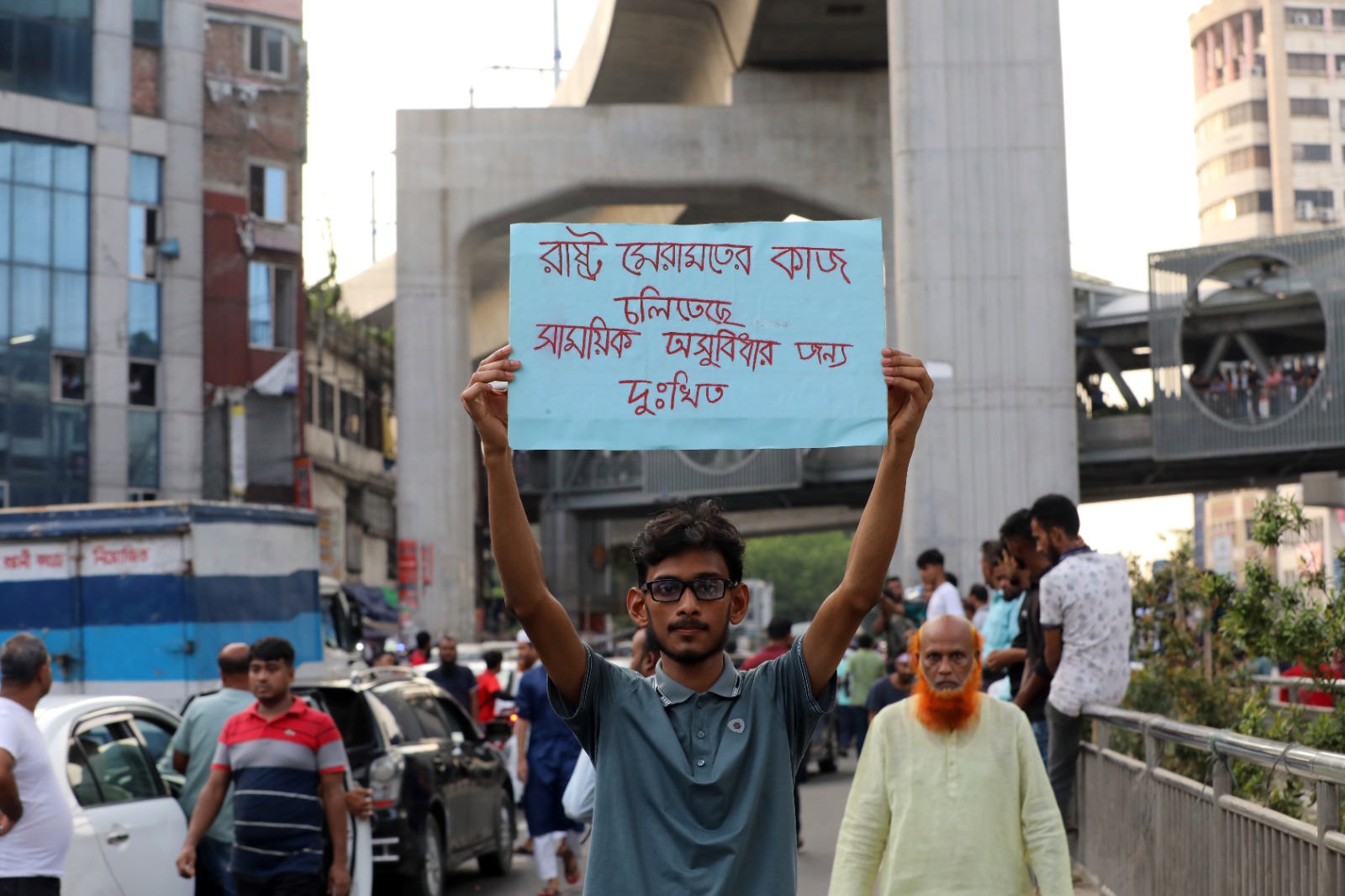
Students of several private universities staged massive demonstrations. Photo: Star
Afia Jannat Ananna, a student of Brac University, said, “As preparation, we studied the quota reform movement, and the legal provisions on quota in government service and the recent high court verdict, because we assumed we would be questioned.”
On July 18, when the students of Brac University along with other private universities in Dhaka took to the streets, the police, in fact, enquired about their stake in quota reforms and told them to return to campus.
“However, when we answered all of their questions and did not move from the street adjacent to our campus, they verbally and physically assaulted us. We quickly went into the ground floor of the university building, but the police threw tear shells and sound grenades inside, injuring many of us,” said Ananna.
Students of several private universities staged massive demonstrations in Banasree, Aftabnagar and Rampura areas. They painted streets and walls with anti-government slogans and blocked all the major intersections to resist the government forces.
“Police and AL cadres fired live rounds at us from point blank range and also from very far away. I saw two protesters get shot in their abdomen and die. I was quite sure that they were killed by sniper shots,” said Arman Sadique, a student leader of East West University.
Private university students put up a strong resistance in Uttara and Mirpur too. Nayeem Abedin, a student of East West and an organiser of the students of private universities, said, “Many students who could not come to the campus staged protests in their own neighbourhoods. In this way, protests spread all over the city.”
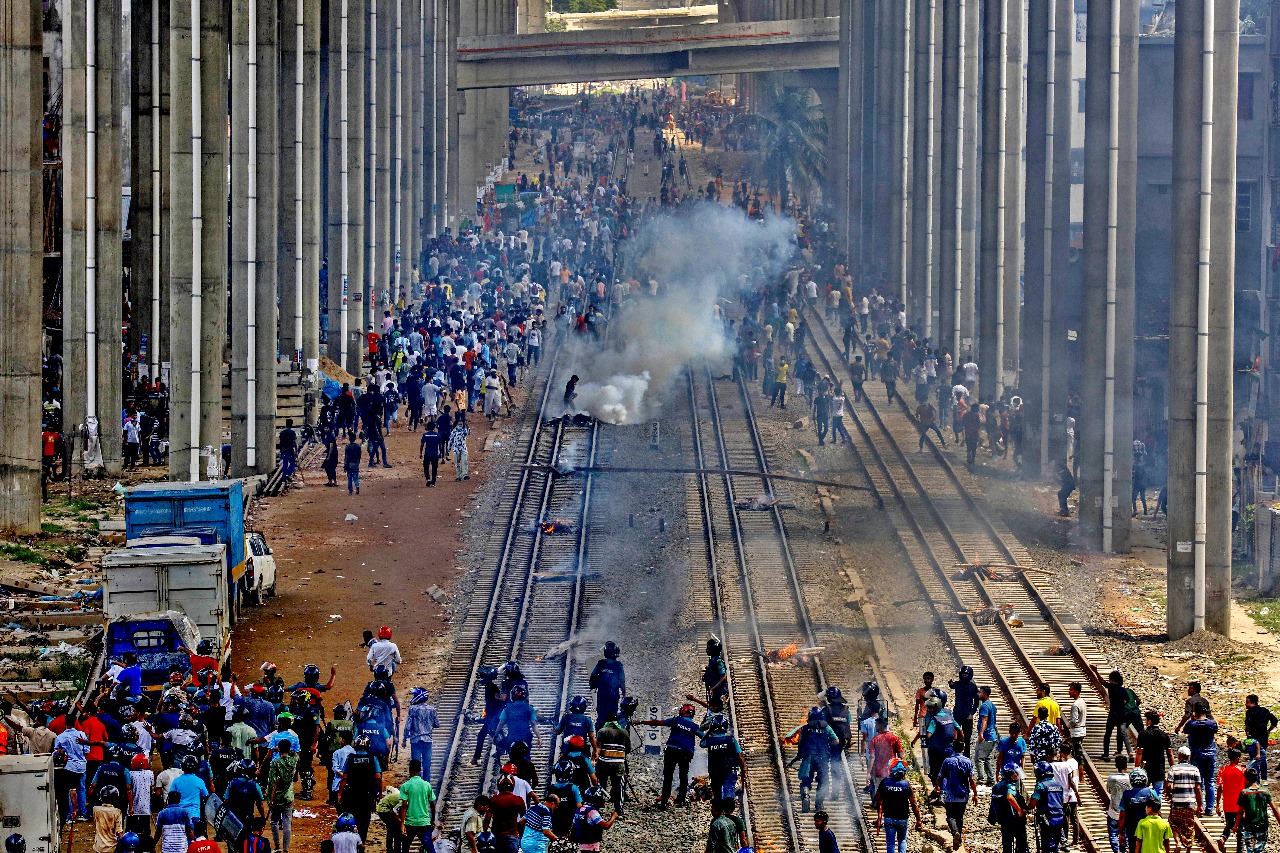
Private university students put up a strong resistance in all the major neighbourhoods of Dhaka and played a vital role in controlling the major streets. Photo: Rashed Shumon
According to Nayeem, private university students played a major role in controlling Dhaka’s major streets. When the central coordinators were announcing blockade and shutdown programmes, these students, many of whom live in residential and commercial areas near the universities, used to block their neighbourhood and nearby major streets such as Airport Road, Gulshan, and intersections of Uttara and Mirpur.
“We were determined to maintain control over the major streets so that police or BGB could not cross a street to attack another group of protesters occupying another intersection or street. In this way, we kept different groups of police and BGB isolated from each other and prevented them from cornering us. Still, too many lives were lost due to mindless, indiscriminate firing,” added Nayeem.
Such contributions from the students of private universities proved to be a lifeline for the protesters in Dhaka. As DU leader Abdul Kader said, “On July 17, when DU authorities ordered all students to leave the dorms and closed the university for an indefinite period, we faced a major crisis. Many students started to leave Dhaka and we thought that our movement would be finished now. But when private university students joined, our movement got a new lease of life. Many students who decided to leave Dhaka threw away their bus tickets and stayed to continue the protest.”
A social media revolution
Students were deeply frustrated by the lack of media coverage of the protests. Many outlets failed to even report on upcoming events announced by student coordinators.
As Abdul Kader explained, “We consistently sent press releases to all TV channels and newspapers. Most ignored our news. The media painted a picture of a country unaffected by protests, but in reality, countless protesters were arrested, abducted, or killed daily.”
Denied by mainstream media, students resorted to social media to spread their message and maintain the movement’s organisation nationwide. Brac student Ananna played a pivotal role in the social media campaign.
“Pro-government groups exploited social media to spread rumours and distract people from the movement,” Ananna said. “They created thousands of fake accounts, spreading misinformation and disinformation to damage the student movement’s image. We worked tirelessly to identify and expose these tactics to prevent confusion.”
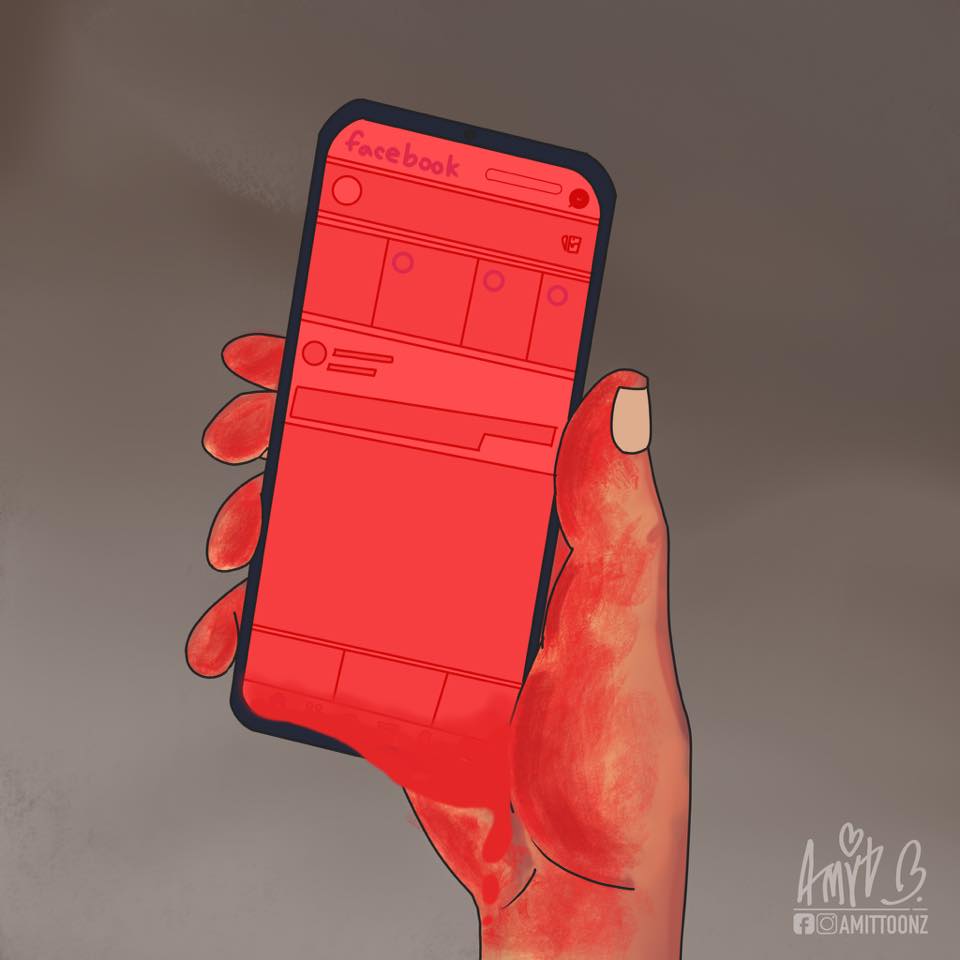
The social media landscape of Bangladesh turned red, demonstrating overwhelming public support for the students’ cause. Visual: Amit B.
Social media served as the movement’s cultural centre. Students wrote and performed protest songs that quickly went viral. Mito Akter shared, “When unable to participate in outdoor events, we sang protest songs and shared them on social media platforms. Many of these songs inspired protesters.”
Students also used social media to educate themselves about the movement and its cause. Munwara Itu noted, “As private university students, we lacked awareness of legal provisions for quota reforms and Bangladesh’s history. We researched these topics and shared content related to the movement and Bangladesh’s history on social media. Content explaining the discriminatory nature of the previous quota system and the role of the ruling party over the past 15 years went viral. We also shared photos and videos of the movement.”
Hasib Zaman, a student leader from JU, emphasised social media’s role in making the movement inclusive and organised. He said, “We held online meetings with student leaders and coordinators nationwide. Student leaders also met with leaders from different political parties to garner their support.”
Regarding campaigns, Abdul Kader explained, “In late July, the government encouraged supporters to use black profile pictures to commemorate August as the month of mourning. Despite numerous martyred protesters, the government ignored our demands. We countered by announcing a red profile picture campaign, symbolising protest, power, bloodshed, and defiance.”
The social media landscape of Bangladesh turned red, demonstrating overwhelming public support for the students’ cause.
From nine points to one
Unable to quell the protests, Hasina expressed interest in negotiating with the students. High-ranking AL political leaders and intelligence officials began contacting student leaders, applying significant pressure to engage in discussions. On July 26 and 27, the Detective Branch (DB) of police detained six movement coordinators. On July 28, the police forced these coordinators to record video statements urging student protesters to postpone all scheduled programmes.
This move by DB further incensed students and the general public. All other coordinators immediately took to the streets, denouncing the video statements.
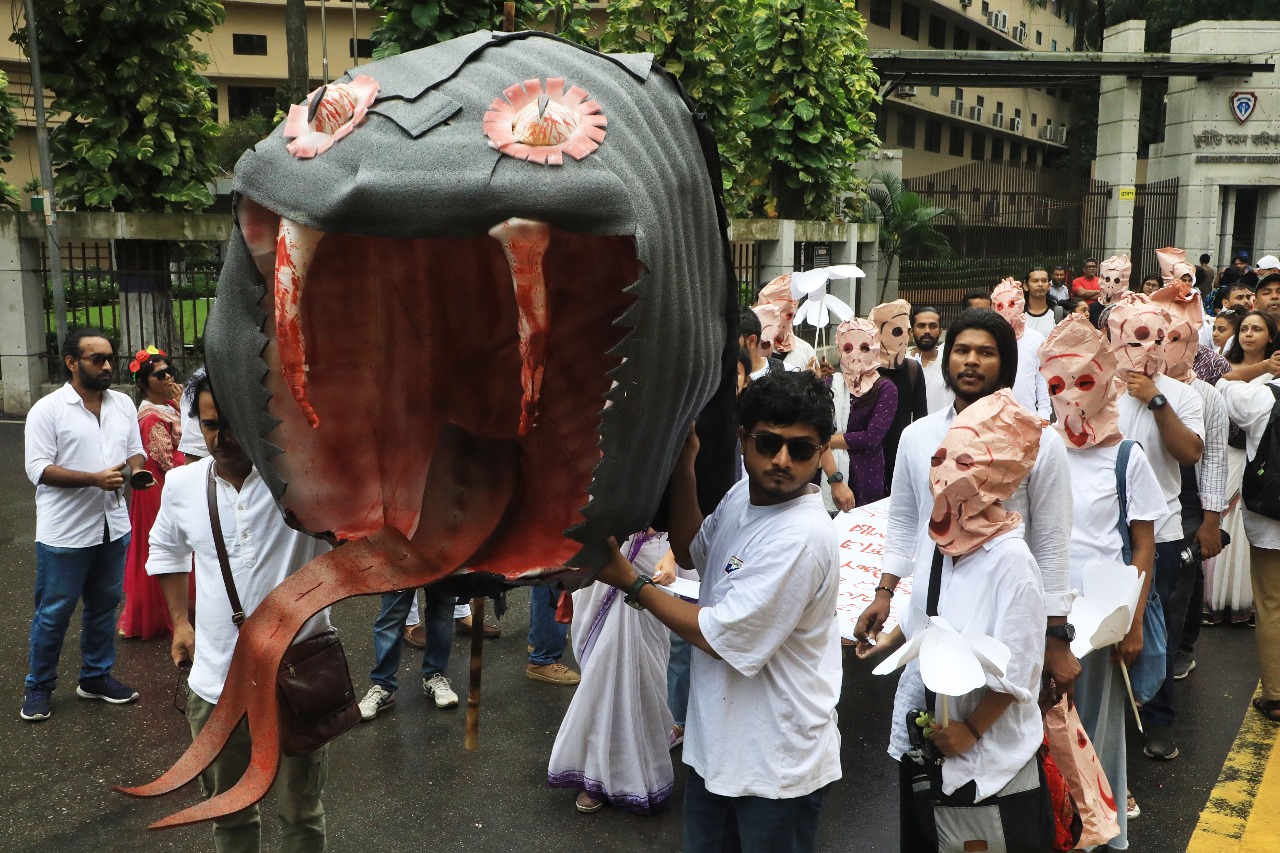
On August 3, the coordinators declared the one-point demand at Shaheed Minar. Photo: Star
The next day, on July 29, Abdul Kader, accompanied by several other student leaders, read out the nine-point demand of the movement, marking a decisive moment in the July uprising.
“Despite immense government pressure to negotiate and assurances of abolishing the quota system, we remained determined to continue our movement until we achieved justice for our martyred, injured, and detained comrades,” Abdul Kader said.
Shadik Kayem stated, “By then, it was clear that the students’ and people’s protest against Hasina’s rule was no longer about quota reforms. Hasina and her administration must be held accountable for murder, violence, and mass arrest of innocent people.”
With the nine-point demand, students made it clear that abduction or forcing students to issue video statements would not deter them. Continuous pressure from students and civil society, led to all six coordinators being released on August 1.
According to Abdul Kader, “We declared the nine-point demand under incredible government pressure and threats. Our lives were at stake. Meanwhile, students and protesters were urging us to announce a one-point demand: the resignation of Hasina and her government. We realised that without Hasina’s resignation, peace and normalcy would never be restored.”
On August 3, hundreds of thousands of students and the general public marched towards Shaheed Minar demanding Hasina's resignation and expressing their support for the student leaders.
The student leaders also called for an all-out non-cooperation movement unless their one-point demand was met.
The final battles
The declaration of the nine-point movement and ultimately the one-point movement sparked massive protests all over the country. Besides Dhaka, every major city and town turned into a battlefield between students alongside common people and government forces. Defying curfew, protesters gathered in thousands at city centres, parks, major streets and other public places demanding Hasina’s resignation and enforcing the blockades and non-cooperation movement.
While police, BGB and AL frequently opened fire at protesters, killing them in hundreds, protesters also resisted and drove them away. Some of the most vicious fighting took place in Jatrabari where protesters sacrificed their lives to take control of the Dhaka-Chattrogram highway.
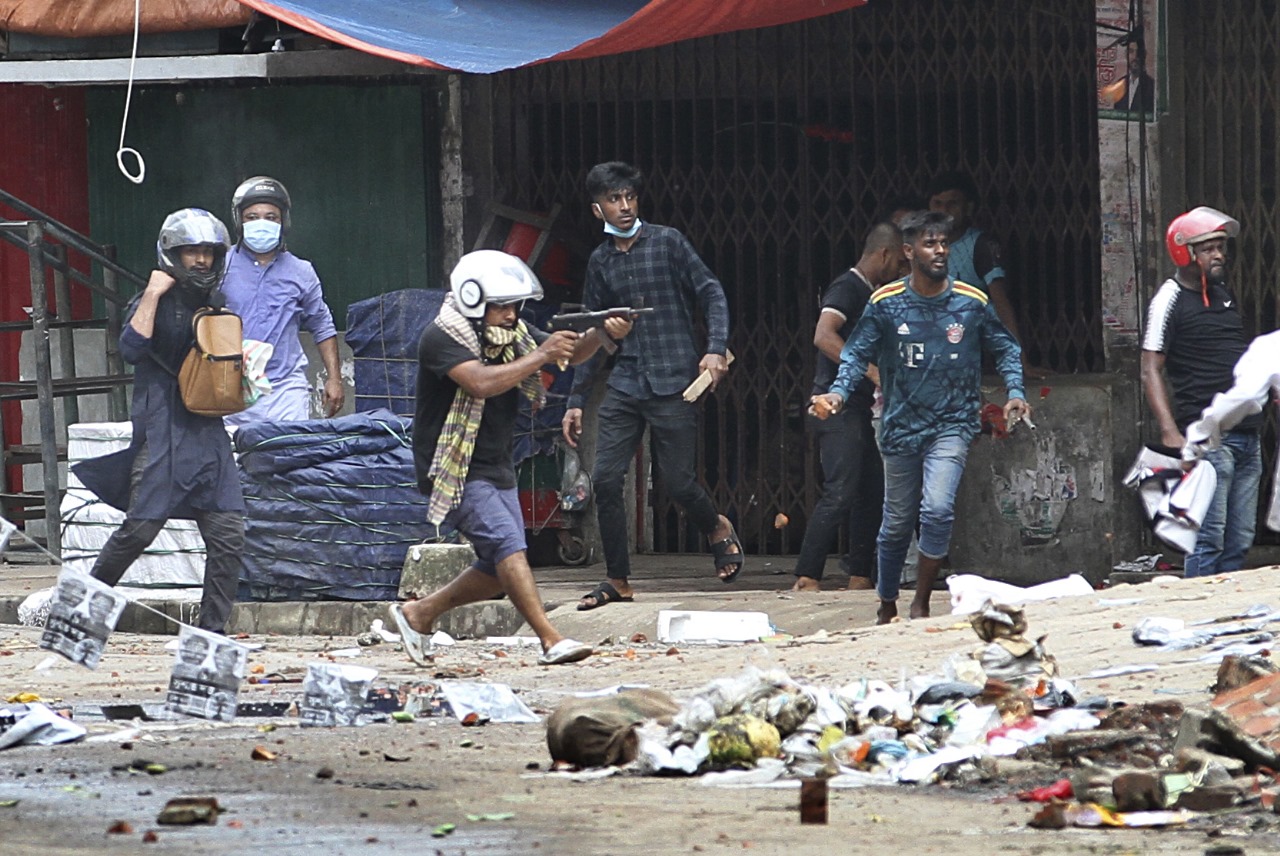
The police and Awami League cadres fired live rounds at the protesters. Photo: Rajib Raihan
Police and security forces were deployed with lethal weapons. They gunned down protesters from armoured vehicles and helicopters. Drones flew over and identified exact locations. However, all these weapons and technologies failed in face of sheer courage and determination of the protesters who were armed only with sticks, bamboos and brick chips.
Md Burhan Uddin Noman, a lecturer of Daffodil International University, said, “I have seen many dead bodies piled up on one another in the streets of Jatrabari. Police only stopped shooting at the protesters when they ran out of ammunition.”
“But still we did not leave the street. We knew that police would hunt us down from our homes if we left. So it was better to die fighting,” added Noman.
Students from JU and other nearby institutions, with the help of workers from Savar and Ashulia, blocked Dhaka-Aricha highway. Roadblocks were placed in all major intersections, cutting off Dhaka from most of the northern and southern parts of Bangladesh.
Officers from Savar and Ashulia police stations made several attempts to dislodge the protesters using lethal and non-lethal weapons, killing many of them.
Hasib Zaman shared, “In the final days of the movement, we found the army on our side. They did not confront us. Their silent support significantly helped us continue.”
In Chattogram, the students staged some of the biggest gatherings the city has ever seen in Lal Dighir Maidan. However, vicious street fighting broke out with AL activists when the students reached Sholashohor station. Students in Bahaddarhat were also resisted by AL.
Mohammad Ali said, “BCL cadres... fired at the protesters. The police also fired live rounds at the protesters killing more than 20 of them in the last four days of the movement. On July 4, the Sholashohor railway station switched hands between the protesters and BAL cadres no less than three times.”
On August 4, a decisive battle was fought at Shahbagh after which BCL went out of action once and for all.
The previous day, BCL threatened that a joint attack by BCL and Jubo League would wipe out the protesters from Dhaka within a few minutes. On August 4, students from different parts of the city gathered at Shahbagh to face the imminent, final assault.
Musaddiq Ali Ibne Mohammad and AB Jubair, two students of DU, organised the resistance that day. Jubair narrated, “I took around 500 students with me and took position at Shahbagh as we got news that BCL activists may try to enter the campus from there. However, when we reached Shahbagh we did not see any presence of AL.”
“Then I learned that some key BCL leaders had taken shelter at BSMMU and a nearby residential hotel. So we surrounded the area. Seeing our manpower, the leaders quickly fled from the hospital, but they set many vehicles on fire to paint us as terrorists. But the fact is our students never entered BSMMU’s premises,” added Mosaddique.
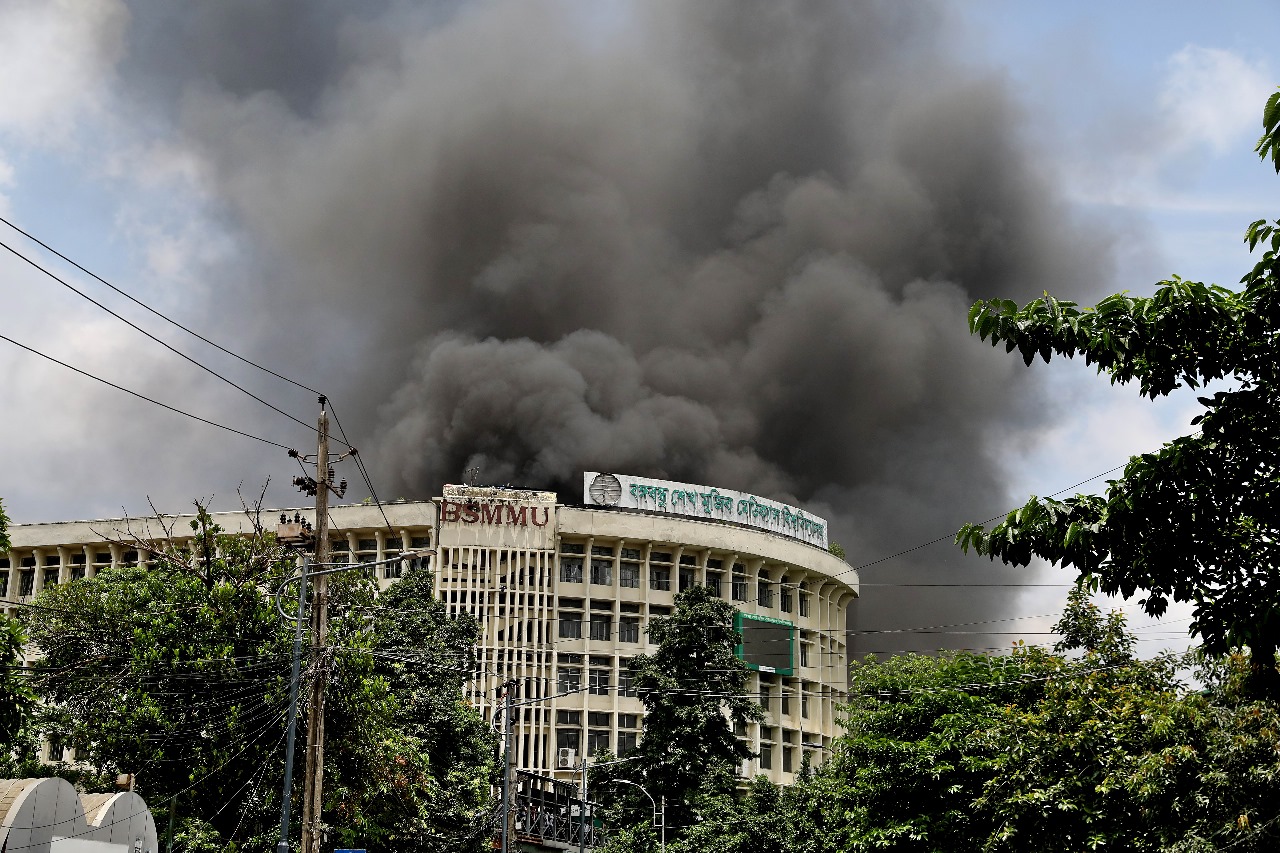
According to student coordinators, BCL set vehicles on fire inside BSMMU to paint the protesters as terrorists. Photo: Star.
Brutal street fighting between protesters and government forces broke out all over the country. Students, factory workers, rickshaw pullers, street children and people from all walks of life also put up a strong resistance in Ashulia, Uttara, in different parts of Chattogram, Sylhet, Rajshahi, Bogra, Thakurgaon, Rangpur and elsewhere.
“Participation of working class people such as rickshaw pullers, transport workers, and factory workers were a major source of strength for us. One street food seller distributed all of his food free of cost for the protesters. Many rickshaw pullers spent their entire day’s income to buy food and water for us,” said Akram. “Many of these people who sacrificed their lives for us might be lying unidentified in some unmarked grave. We must remember these unsung heroes and their stories must be written.”
Students united for one demand
During the July Uprising, students from different political ideologies formed a common alliance under the platform “Students Against Discrimination.”
Students from Chhatra Dal, Chhatra Shibir, Chhatra Shakti, Chhatra Union, Chhatra Federation and other different groups and non-political, apolitical students voluntarily worked with each other, leaving behind their differences, to fight against the autocratic regime.
Akram, one of the key organisers of the movement, said, “We knew the political orientation of the major figures of this movement. When Hasina’s government started killing people, we realised that this movement was going to be a prolonged campaign. So we asked all the students to leave behind their political differences and remain united to defeat fascism”.
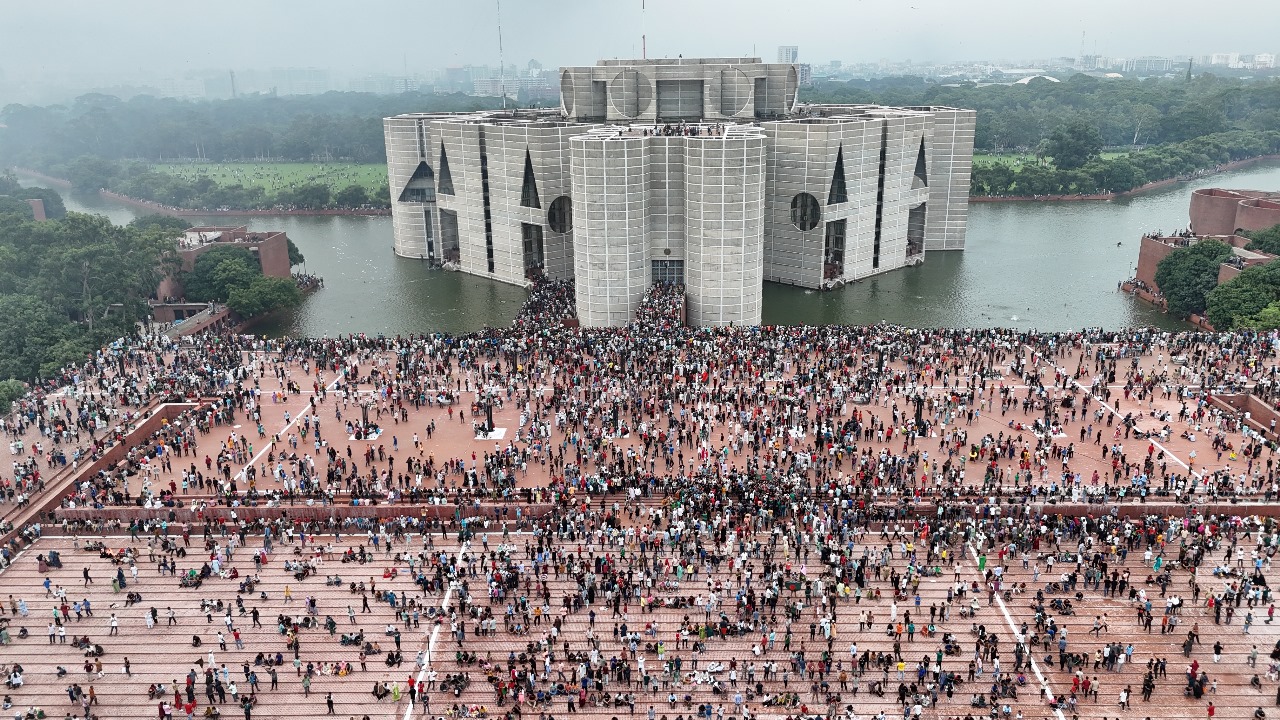
On August 5, Sheikh Hasina hastily fled to India leaving behind a legacy of corruption, murder, injustice and a country on the verge of economic collapse. Photo: Star.
Hasib, the leader of a left-wing student group Chhatra Union said, “Different student groups that were affiliated with political parties maintained their connection with their political leaders. But till August 5, they never tried to push their political agenda. This is how we could stay united and I believe if there is any attempt to restore fascism, we shall be able to resist again.”
Such a sense of collaboration between right-wing student groups like Shibir and left-wing groups is unprecedented in the recent history of Bangladesh. How did such collaboration work?
When asked this question, Shadik Kayem said, “We wanted to establish a democratic Bangladesh where people will be able to live with freedom and dignity... We generated ideas together and helped each other organise the movement and motivate the students. I don’t say he or she is the mastermind of the movement. I say that all the students and mass people who helped us and participated are the heroes.”
Fall of Hasina
On August 4, when students announced the march to Dhaka programme, at least a million people started their march from different locations. The coordinators disseminated messages to all the districts, instructing people to use different and specific routes to enter Dhaka to avoid bottlenecks and to overwhelm the security forces by rushing in from all sides.
Thanks to their strategic planning, by morning hundreds of thousands of people were already marching towards Gono Bhaban, Hasina’s official residence. She hastily fled to India leaving behind a legacy of corruption, murder, injustice and a country on the verge of economic collapse.
Nayeem Abedin shared, “We did not think that Hasina would flee. We were actually planning to keep her residence under siege for some time. However, we were overjoyed to know that she was finally gone.”
In fact, the students were already worried about their next course of action. According to Abdul Kader, “As we were preparing for a prolonged siege, we did not have the time to think about the post-Hasina government. We were really lucky that Dr Yunus accepted our request and took charge immediately.”
Concerns still remain
Almost two months after the fall of Hasina, most of the students did not get a chance to celebrate. Tackling several attempts to destabilise the country, helping the newly-formed government to restore the administration and reaching out to the flood victims, they have been constantly in the field to respond to any crisis that may endanger the interim government.
Students who took part in the movement from different political affiliations are now resurfacing in the political scene and claiming their stake in the post-Hasina government. As a result, tensions between different student groups are forming. This has raised a new concern among the students: will Bangladesh return to violent political infighting again?
Abdul Kader said, “Different student groups may have varying political ideologies but they must not impose their ideologies on others. Clashes between student groups occur when they start the politics of occupying campuses like they did during the previous regimes. If they try to do so, they are propagating fascism and we shall resist them like we resisted AL.”
Mito Akhter opined, “We are afraid that if the conflict between student groups continues to rise, political parties may grab this opportunity to create division among students and exploit them for their own political interest. This is why we proposed that partisan student politics should be banned from universities and central student union-centric politics should be encouraged in the university.”
Besides political feuds, students are also concerned about visible discrimination among students belonging to different institutions. There is a sense of deprivation among the students of private universities, madrasas and other institutions who played a major role in the movement but have been “forgotten” after the goal was achieved.
Brac’s Afia Jannat Ananna said, “It is really unfortunate that after forming the government, students of private universities have completely been brushed aside. Our role has been forgotten. Many important steps have already been taken by the interim government, but we did not have any chance to share our thoughts and opinions on those matters.”
Students are also concerned about preserving the history and essence of the July Uprising. Attempts of disowning the slogans, erasing graffitis and forgetting the protest songs have created concerns.
AB Jubair said, “On September 14, two months after the day when we made the historic ‘Razakar’ slogan, some student leaders tried to denounce it on social media. I agree that the slogan is heavy with context. But, we should preserve history so that the next generation can learn about the context; we should not denounce it.”
Students are also dissatisfied about the fact that the government made no effort to preserve the graffiti and songs that were made during the days of protests. In some places, the graffiti was erased to make way for aesthetic paintings, new slogans or calligraphies.
Students are also concerned over many unmet demands that they raised during the protest.
“Various demands that we mentioned in the historic nine-point movement have not been implemented,” explains Akram. “Many of those demands are still unfulfilled. Many perpetrators of the massacre are still serving in the administration, and many key political leaders who ordered the massacre are still free. We feel that the administration is not cooperating in this regard, and it is a matter of great concern for us. This is why we have formed the Nagorik Committee so that we can act as a pressure group for the government. I think more pressure groups like these should be formed by the students and conscious people to guide the government.”
Md Shahnawaz Khan Chandan is an Assistant Professor at Institute of Education and Research, Jagannath University. He can be contacted at s.nawazk28@yahoo.com
Back to Homepage